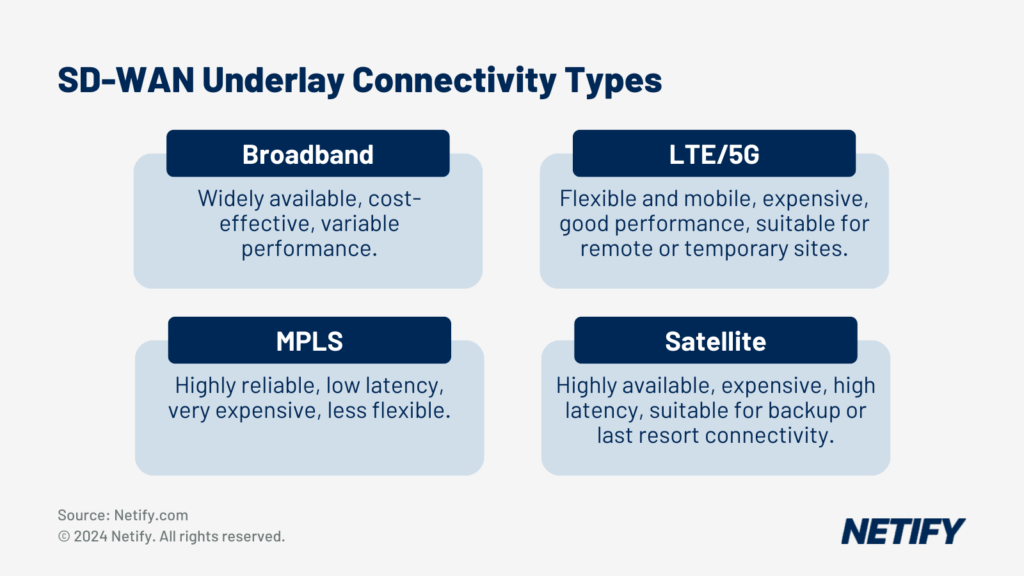What is SD-WAN Path Selection?
| Path selection capabilities in SD-WAN allows traffic to be dynamically routed over multiple network underlays. |

Software-Defined Wide Area Network (SD-WAN) solutions offer businesses with the capability to utilise path selection through dynamic traffic routing in order to increase network performance and reliability. SD-WAN leverages multi-path utilisation, analysis of real-time traffic conditions and network policies to optimise network performance and ensure that critical applications are provided adequate resources to prevent any degradation of traffic. This means that factors such as latency, jitter and packet loss are minimised, increasing user experience.
Due to SD-WAN path selection intelligently distributing network traffic over multiple WAN connections, such as MPLS, internet broadband and cellular links, not only is the performance optimised but organisations can also reduce costs by using cheaper connections.
By monitoring real-time network conditions, SD-WAN path selection can compare network telemetry to historical data in order to predict potential issues and rectify the network before these can take effect. By seamlessly and proactively switching between network paths, SD-WAN provides an improved user experience (UX) and maximises uptime when compared to traditional WAN networks.

Technical Overview of Path Selection
SD-WAN solutions utilise path selection by monitoring and considering network health, performance of network paths, real-time metrics for bandwidth availability, latency, jitter and packet loss. These factors allow an assessment of each network path and, when combined with SD-WAN traffic prioritisation policies, it enables the network to determine the suitable link type to use for the specific traffic.
Application-aware routing allows network administrators to define prioritisations for traffic directly within the SD-WAN controller based on the specific requirements of the application. This means that latency-sensitive applications such as VoIP and video conferencing are routed via the lowest latency path, whilst bandwidth-intensive applications are routed across paths with high bandwidth availability.
To further improve network communications, SD-WAN routing uses techniques such as Forward Error Correction (FEC), packet duplication and packet reordering. These increase the reliability of communications by reducing the impacts of packet loss, improving network availability.
Benefits of Effective Path Selection in SD-WAN
There are many benefits to effective path selection with SD-WAN.
One such benefit is that, through distributing traffic across multiple paths, network efficiency is increased. This is due to network utilisation being maximised and prevents any single network link becoming overwhelmed with traffic. This improves network performance and enables lower-cost links to be leveraged, lowering operational costs.
To enhance application performance, SD-WAN path selection ensures that crucial applications are prioritised and receive adequate network bandwidth. This provides faster response times, reduces latency and therefore improves the user experience.
For increasing reliability, dynamic routing reduces the risk of network failures (packet loss) by reducing network congestion. In the event of a path outage, SD-WAN is capable of redirecting traffic seamlessly from one traffic link to another, creating continuous connectivity with no downtime.
SD-WAN path selection provides cost savings as it enables the use of existing infrastructure and reduces reliance on dedicated circuits, which can be expensive. This means that businesses can leverage low-cost broadband internet and cellular networks alongside MPLS solutions in order to achieve cost savings whilst not compromising on network performance.
Implementation Considerations
When implementing SD-WAN path selection, it is important to consider the following factors:
The network design must be evaluated due to being essential for effecting routing. This requires IT decision makers to define their network topology, select appropriate SD-WAN appliances to suit their topology and network requirements and outline their policies for routing configuration.
Choosing the correct SD-WAN vendor solution is crucial for optimising network performance. By basing this decision on vendor offerings such as performance enhancements, scalability, ease of management, ability to integrate with existing infrastructure and security capabilities, IT decision makers can choose the most-suited SD-WAN solution that provides path selection to the network.
By defining clear and comprehensive network policies, this assists SD-WAN path selection priority specification and thus ensures that traffic is routed across the optimal path based on the application reliance and importance on the network.
Challenges in Path Selection
There may be challenges implementing SD-WAN path selection within complex network architectures. Large, distributed environments, with multiple sites and a mix of network technologies, increases complexity and therefore makes implementation more difficult. In this instance, where businesses have complex requirements but lack a team of knowledgeable network administrators, it may be most appropriate to consider fully managed SD-WAN solutions. This means that the solution is handled by the vendor and should provide the network with the best integration of path selection for optimised performance despite the network complexity.
When utilising multiple network paths, such as during high volumes of traffic, it is important to understand the security differences between each traffic link. For example, using public internet links may need end-to-end security such as encryption, firewalls and secure tunnels in order to protect data from unauthorised access whilst in transit.
Another potential challenge is the integration of legacy systems. These may lack the features that newer systems offer and therefore when integrating SD-WAN path selection, there may be the requirement to adapt existing infrastructure in order to ensure interoperability and to maintain the benefits that path selection provides to the network.
To get the most out of SD-WAN path selection, it requires network administrators to continuously consider network policies, monitor network conditions and evaluate changes in application requirements. Due to these constantly varying factors, network administrators will need to adapt network policies and maintain network components in order to meet demands and fully optimise the network.
Future Outlook and Innovations
Artificial Intelligence (AI) and Machine Learning (ML) are being increasingly used for automatic path selection capabilities. These models are trained on large data sets, enabling SD-WAN path selection to consider traffic patterns, real-time network telemetry and application requirements in order to provide optimised traffic routing based on current network behaviour and application requirements. These technologies can also be used to automate the process of creating Quality of Service (QoS) policies to determine application priorities. These therefore reduce the workload for network administrators and increase the speed in which the network can adapt to a changing environment, therefore boosting user experience.
Due to frameworks such as SASE, SD-WAN is increasingly being integrated with the cloud. Through optimising path selection to connect to the cloud, the tighter integrations enable seamless high performance to cloud applications and services.
SD-WAN solutions are beginning to support Internet of Things (IoT), which often adds a large volume of devices that transmit large volumes of traffic. In order to accommodate this, path selection assists with low-latency communications, therefore enable edge computing and scaling.
Conclusion
In conclusion, SD-WAN path selection offers enhanced performance, reduced costs and increased reliability to networks through intelligent traffic routing. By dynamically distributing traffic across multiple communication links and prioritising critical applications, SD-WAN maximises network efficiency and improves the overall user experience (UX).
By integrating artificial intelligence and machine learning, SD-WAN path selection can automatically adapt to changes in network environments and demands in real-time, simplifying the workload for network administrators.
However, implementing SD-WAN path selection can be challenging within complex or large-scale environments, especially where legacy systems are still in operation or environments where there is a lack of SD-WAN knowledgeable network management. Therefore, it is important that IT decision makers consider the SD-WAN vendor key offerings in order to ensure the best solution to meet their network requirements is leveraged.